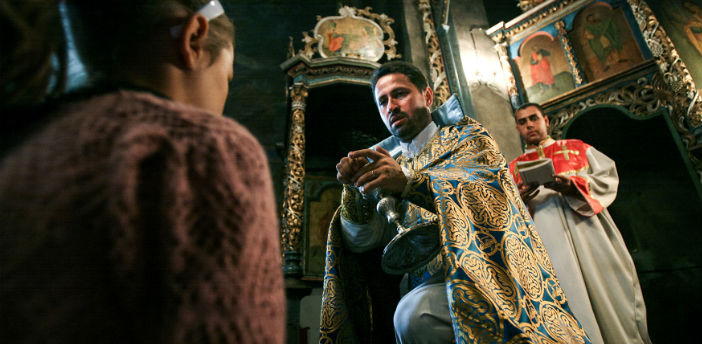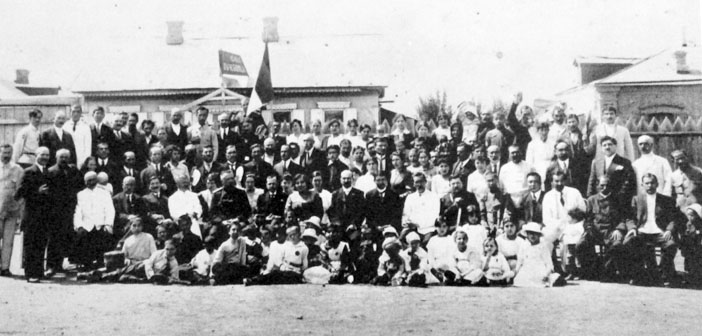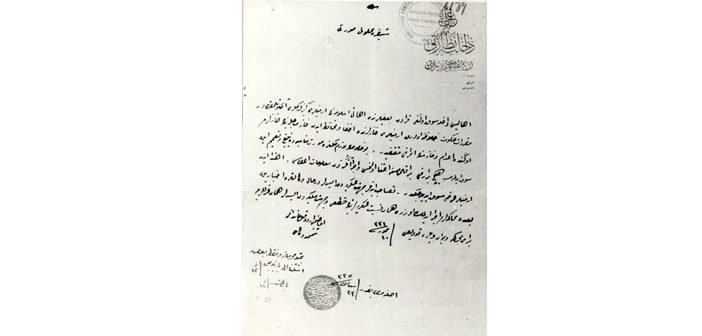Romanian photojournalist Anreea Tanase’s “Armenians in Romania” project was presented by interviews, book launches and photo exhibitions in Bucharest, Cluj-Napoca, Yerevan, Gyumri. We talked to Tanase about her journey to the history of Armenians living in her country and her work, in which the traces of genocide from past to present is documented.
Experienced photojournalist Andreea Tanase turned the journey of Armenians living in her country into a special work, in which the traces of genocide from past to present is documented. Her “Armenians in Romania” project was presented by interviews, book launches and photo exhibitions in Bucharest, Cluj-Napoca, Yerevan, Gyumri. One of the photographs from the “Armenians in Romania” project won the international competition “A Europe of Diasporas” this year, and two photos from the same project were exposed on May 2, in a photo exhibition in the European Parliament, during the conference “A Europe of Diasporas”. Andreea Tanase told about this work, which started as a sincere personal curiosity toward and then turned into o professional interest, history of photography and its power to record the present.
When and how was your first exposure to or encounter with a small community such as the Armenians in Romania?
I am often asked why Armenians, why I chose to document this community. I admit that I learned later about the Armenian Genocide, not from history books as I should have, but from the lyrics of the rock band System of a Down. For me it was a decisive moment, and as I started reading about the genocide, the idea of documenting and creating a story about Armenians in Romania was born. This project was developed over time, revealing how strong the Armenian community has been in my country and how big their influence in economic, social, political and cultural life in Romania. Many important personalities of my country were of Armenian origin. In Transylvania, a region in central Romania, there were three Armenian towns, Gherla or Armenopolis, as was the original name, Dumbraveni (Elisabetopol) and Frumoasa, and also in the town of Gheorgheni lived an important Armenian community. In Moldova, the Armenians were very influential especially in the field of trade, the main trade routes intersecting in this area. One of Moldova's rulers, Ioan Vodă the Terrible, was of Armenian origin; an important businessman, owner of an inn and a diplomat in the early nineteenth century, Manuc Bei was Armenian; Vazken Balgian became Vazken I, Catholicos of All Armenians, was born in Bucharest, Romania; and presently there are two important politicians of Armenian origin, Varujan Vosganian and Varujan Pambuccian. Romanians know very little about Armenians who are often confused with Macedonians or Albanians. Textbooks contain very little information about Armenians and very few or no references about the Armenian Genocide. This is why I chose to document this community and talking about Armenians and Armenian Genocide has become a priority for me.
How easy was the access into the Romanian Armenian communities? Is it a tight and inaccessible community? How did you manage finding contacts? Did you travel extensively to photograph?
For this documentary, I traveled to 16 towns in Romania, in Moldova, Bulgaria and Armenia. I photographed, had interviews taken and consulted books and archives. My book does not consist of photographs only, as it also contains interviews and historical references. It is not a simple photo album but a documentary material that combines images with text or as I like to say, the text flows from the photos. A great help in the documentation was Mihai Stepan-Cazazian, editor-in-chief of the Armenian magazine "Ararat", who gave me most of the information about the community, and provided contacts with community leaders in the country. Mr Cazazian became one of the major supporters of my project, because of which I will always be grateful to him. Having his recommendation made it easier for me to get into some communities, but not everywhere. Romania's Armenian population, especially the elderly still hold on to a fear from every stranger and especially from journalists, induced by a state of psychological terror reminiscent of the communist era. I was greeted with a dose of skepticism many times, and sometimes I was denied the request to conduct interviews or to photograph certain things. To complete the stories of some communities I had to return for a second time. Not everyone understood my journalistic approach and many have wondered why I had to photograph their community for so long. But a high quality documentary cannot be achieved overnight as it takes time to know and understand the community and to uncover its stories.
Why did you start this story in the book? Why did you feel the need to tell it? Was it a simple "human curiosity" or a need for "photography with responsibility"?
As I answered this question in the first part of the interview, I will bring only an additional comment since I consider it important. Any journalist who learns about a topic that is little known wants to talk about it. When you find its importance, the desire to document it amplifies. Personal curiosity turns into professional interest, and the journalist begins to discover stories he or she finds interesting and important to the public. A journalist may not always be able to change people's perception about the situations they document, but at least manages to grab their interest and introduce them to things they knew little or nothing about. In a documentary of this scale it is almost impossible not to let yourself get influenced as a journalist by the people you come to know and their stories. A journalist, whether writing or photographing, will always bring a personal touch to the text or photographs, but the extent of it depends on each individual. The vision when presenting a topic is based on this personal touch as well as one's journalistic experience.
Why did you feel the need to understand the tragic history from the past of a community to which you do not belong? How does it relate to the notion of searching for the truth and not staying silent?
I consider that it is very important to know our history, understand and accept it, with all its bleak moments. The tragedy of a nation, as genocide is, affects and concerns us all. It is essential to know and to understand why the Armenians live in Romania. My country was one of the first to open its doors to receive Armenian refugees during the genocide. As a result of that policy, the country's laws were amended and the nature of ethnic communities has changed.
One of the readers of my book is an Armenian who now lives in New York. I like to know the people who buy my book and each time when I have the opportunity I ask them where their interest in buying such documentary materials comes from. In my book, the chapter about the Armenian Genocide tells the story of 198 refugee children of the Armenian Genocide, who arrived at the port of Constanta in 1923 and were housed for a few years in the orphanage at Strunga (365 kilometers from Bucharest). The register that contains the photos and details of these children still exists; it has been digitalized and can be accessed online. I sent the link to this register to the NY Armenian man I mentioned above,and received the following answer: "Hrant Hovnanian, my father, is on page 20 entry number 118, and next to the photo, written in Armenian, Original photo was sent to NY. Piuzant, the younger brother, is on page 11 entry number 49. He died in Bucharest and is buried at the Armenian cemetery in Bucharest. Vahram, the youngest brother is on page 4, entry number 21, and had the same fate as Piuzant. Elder brother Kricor was not at Strunga, but stayed with his grandmother in Bucharest to make a life for himself." I think this story tells us all about the importance and the role of journalistic approach and the fact that we must not forget the past, but we have to always remember it and understand it, because it is part of the present.
When Hrant Dink was assassinated, I think everyone understood that the Armenian Genocide did not end a century ago, but that it is still ongoing. Unfortunately, history repeats itself, it is cyclical, and tragedies like this still take place right before our eyes. I do not know if we will ever learn anything from past mistakes, but we have the duty to speak about them.
In 2015, the Peasant Museum in Bucharest organized an exhibition of Armenian photos and objects, which was open for a month. Initially, organizers wished this exhibition to be dedicated to the commemoration of the Centennial of the Armenian Genocide and begun efforts to present the exhibition. I was invited to hold an exhibition with the photographs from the photobook "Armenians in Romania" and I was offered a room to exhibit the photos. One day before the opening, I received an email from the organizers who informed me, that regretfully after the intervention of the Turkish Embassy in Romania they were contacted by a representative of the Romanian Government to change all the references to the word genocide in this exhibition, including explanations of the photographs. I must say that some of the photos were taken at the Monument of Genocide Museum in Yerevan. This was a violation of my copyright on the one hand, and on the other hand of my right to free speech. At that moment I could not get involved in changing that decision, because I was in Armenia documenting events comemorating the Centenary of the Armenian Genocide. Later, I commented on the decision of the museum, which entailed a series of troubles, but the organizers of the exhibitions were the ones suffering the consequences having being called to the Turkish Embassy to give "explanations". I wish I could do more, but after I had met with a lawyer I understood that I stand no chance to win a possible lawsuit against the authorities without any support.
What are some of the warm or sad surprises that you encountered while doing this story?
In my travels I have met many interesting people and beautiful stories. The destinies of everyone with whom I spoke are linked in a lesser or greater extent to the Armenian Genocide. Many of the stories have a touch of sadness and nostalgia, but all Armenians in Romania I have spoken to told me that they are grateful to this country that offered them the opportunity to weave their destinies in an honorable way and offered them a home. There are Armenians in Romania who have never visited Armenia, but always dreamt about it. There are Armenians born in Romania who now reside in Armenia, who are taking imaginary journeys through the streets of their childhood. There is a story in my book of an Armenian from the village of Frumoasa, Transylvania, who wrote and read in the Armenian language daily in order to not forget it. I must say that in Transylvania the Armenian language was lost, as very few people still speak it. Also in Transylvania, in Dumbraveni town, a priest who served in the Armenian church wished that his heart be preserved in the church, and that is where it is today.
How did you fund the costs of travel and publication? Were doors opened to you or did you have difficulty in making people get interested in helping you publish it?
This documentary was supported entirely through my own personal funds, including the printing of the book. I wanted to remain as independent as possible in terms of content and to present the story as I myself discovered it, without pressure on my perspective from anyone. To see this book printed I have made many financial and personal sacrifices, but this is not the proper moment to talk about it. I decided to do this because I find it very important to get out of my individual comfort zone and take a proper look at the people around us. For me this is very important and I hope that through my book people will understand why it is so essential to get to know others and know our history. As for technical details, I had big problems with printing the album because of its size. It is a book of 400 pages, 315 x 236 mm in size and weighing three kilograms. I was forced to reprint it, because the first print-run had to be compromised, ruining several of my book launches that had already been arranged, and which were held without the book at hand.
What is the situation of documentary photography, and photography in general, in Romania?
In Romania, as everywhere else in the world, interest in photojournalism or documentary photography is very low. There are several documentary projects in Romania that have been done very well, but the tendency to take this type of photography seriously is not high. Cost and time for such projects are very high and it is hard to find sponsorship for them. Most of the time, my photographer colleagues work at different jobs, and the money they earn is used to finance their projects by themselves. However, It is good that there are people who do that, regardless of the difficulty of doing it and the problems they encounter. It is good that they find the strength to go on, even if often they want to quit. Documenting the world around us is an essential thing for us as people, for our descendants. We must not close our eyes on things that happen around us, because we have to fight with those who want that information on historical events to be altered.
You travelled all the way to Moldova and Armenia even though the book is about Armenians in Romania. Did this whole experience awaken in you some need to explore more? Maybe the Diaspora Armenians? Maybe even Armenians in Turkey? What are your future aspirations as a photographer?
For me photography or photojournalism, in the way I approach it, is not just a job but a lifestyle, and I hope I can always continue to do that, although it is very difficult to find sponsorship for my projects. I wish I could document other Armenian communities around the world as well, and I would like to photograph all the monuments that make the connection with historical Armenia. I would also like to meet the Armenian community known as Hemshin or Homshetsi and to photograph the ruins of the cities built by Tigran the Great, the Tigranakerts. I have a major interest in the Assyrian community in Europe and I hope I can soon begin a project on their communities. It's an old idea, triggered by the desire to document modern Aramaic-speaking populations. A major project that I will begin this year is my PhD, and the topic that I will address is the photography done during the Armenian Genocide, as a documentary material.
A life devoted to photography: Andreea Tanase
Having 15-years-experience in press photography, Andreea Tanase has a Communication and Public Relations degree from the Ecological University of Bucharest, graduated from the New York Institute of Photography, USA, has completed photojournalism courses organized by the Centre for Independent Journalism in Bucharest and completed a Master’s degree in Information Management in Combating Terrorism at the Intelligence Academy “Mihai Viteazul” in Bucharest.
In her career she has addressed varied topics, from news to social reports and photo documentaries and explored Romanian life and culture. She has worked for top newspapers in Romania, and collaborated with major magazines and photo agencies in Romania as well as abroad. Her photos and articles have appeared in publications such as National Geographic Romania, Geo Romania, Foreign Policy Romania, British Photo Agency, Intact Images, Ostphoto, Amnesty International Journal, Ararat Magazine, Die Welt, Die Tageszeitung or Die Presse.





